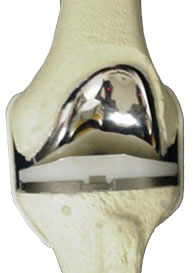What is total knee replacement (TKR)?
It is also known as total knee arthroplasty (TKA). Knee replacement surgery involves replacing the worn out (diseased and painful) surfaces of the knee joint with an artificial knee joint (implant) designed to allow movement and stability close to that of a normal knee.

Knee replacement implant in a plastic bone model
Who needs a knee replacement surgery?
The two commonest indications for knee replacement surgery are osteoarthritis (OA) and rheumatoid arthritis (RA). In these patients the need for surgery arises when pain becomes unbearable, deformity is severe and the patients’ activities of daily living (ADLs) are severely affected.
What are the benefits of knee replacement surgery?
The primary benefit that a knee replacement offers is relief of pain. Additionally it allows correction of deformity and restoration of movement and joint stability. This leads to improved mobility and knee function, and allows return to activities of daily living. The amount knee flexion (bending) one can get after knee replacement depends on the amount knee bending present before surgery, the quality of bone, the status and strength of the ligaments (collateral ligaments), the type of implant used, and the post-op rehabilitation (physiotherapy). Patients who are over weight may not get full flexion in their knee.
What are “do’s and don’ts” after knee replacement surgery?
Majority of the patients with knee replacement are able to perform most of their activities of daily living. Most patients are able to walk without any walking aid, though some older patients may need to use a walking stick for support. Patients can climb stairs and sit and get up from a chair or couch on their own. Most patients can bend their knees to more than 120-130 degrees, and are able to squat and sit cross-legged (Indian style sitting). These activities need specific rehabilitation (exercise program) after surgery. It is however recommended that patients avoid such activities on a routine basis as it may put an undue strain on the knee which increases the wear and reduce the longevity of the artificial joint. Use of western-style toilet is also recommended. Patients may be able to play sports like golf and tennis and drive a car once they have fully recovered from the surgery. Complete recovery may take about 2-3 months.